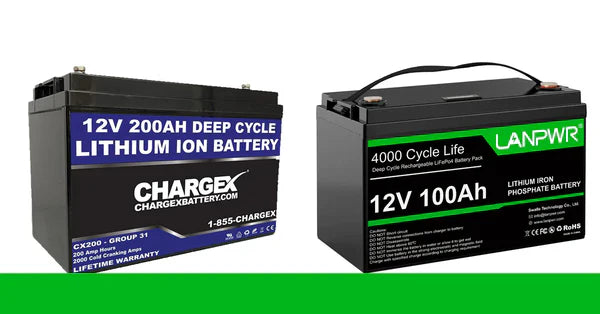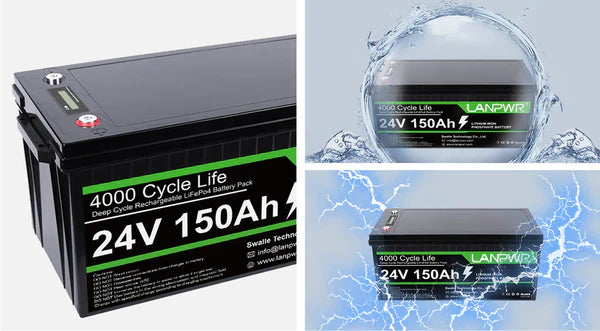Lithium Iron Phosphate (LiFePO4) batteries are increasingly popular due to their high safety profile, long cycle life, and stable chemistry. One of the most important aspects to understand about these batteries is their charging capabilities. This article provides a detailed exploration of how fast LiFePO4 batteries can be charged, the factors that influence charging speed, and best practices for optimizing charging while ensuring battery health and longevity.
Understanding LiFePO4 Battery Chemistry
What are LiFePO4 Batteries?
LiFePO4 batteries are a type of lithium-ion battery that uses lithium iron phosphate as the cathode material. This chemistry offers several advantages over other lithium-ion batteries, such as higher thermal stability, longer cycle life, and enhanced safety due to its stable electrochemical properties.
Key Characteristics:
-
Stable Voltage: LiFePO4 batteries typically operate at a nominal voltage of 3.2V per cell, with a fully charged voltage of around 3.65V per cell.
-
High Cycle Life: These batteries can endure thousands of charge-discharge cycles with minimal capacity loss.
-
Safety: LiFePO4 batteries are less prone to overheating and thermal runaway, making them safer than other lithium-ion batteries.
Charging LiFePO4 Batteries
Charging Speed
The charging speed of a LiFePO4 battery is determined by its charge rate, often denoted as C-rate. The C-rate is a measure of the charge or discharge current relative to the battery's capacity. For instance, a 1C rate means the battery is charged or discharged at a current equal to its capacity (e.g., a 10Ah battery charged at 10A).
Typical Charging Rates:
-
Standard Charge: LiFePO4 batteries are typically rated for a standard charge rate of 0.5C to 1C. This means a 100Ah battery can be safely charged at 50A to 100A.
-
Fast Charge: Some LiFePO4 batteries can handle higher charge rates, up to 2C or even 3C in certain conditions. This translates to charging a 100Ah battery at 200A or 300A, significantly reducing charge time.
Factors Affecting Charging Speed
Several factors influence how fast a LiFePO4 battery can be charged safely and efficiently:
Battery Capacity: Larger-capacity batteries can handle higher absolute charging currents while maintaining the same C-rate.
Temperature: Charging speed can be affected by the temperature of the battery. Optimal charging temperatures for LiFePO4 batteries are typically between 0°C and 45°C. Charging outside this range can reduce efficiency and potentially damage the battery.
Battery Management System (BMS): A BMS is crucial for monitoring and managing the charging process. It ensures that the battery is charged within safe parameters, balancing the cells and preventing overcharging.
Charger Specifications: The capabilities of the charger, including its maximum current output and voltage regulation, play a significant role in determining the charging speed. A high-quality charger designed for LiFePO4 batteries is essential for fast and safe charging.
State of Charge (SoC): The initial state of charge can affect charging speed. Batteries charge faster when they are at a lower state of charge. As the battery approaches full charge, the charging current typically decreases to prevent overcharging.
Charging Stages
Charging a LiFePO4 battery typically involves two main stages: Constant Current (CC) and Constant Voltage (CV).
Constant Current (CC) Stage: In the initial phase, the charger supplies a constant current to the battery. This phase can handle high currents, and the voltage of the battery gradually increases.
Constant Voltage (CV) Stage: Once the battery reaches its maximum voltage (usually around 3.65V per cell), the charger switches to constant voltage mode. The current gradually decreases while the voltage remains constant until the current drops to a minimal level, indicating that the battery is fully charged.
Optimal Charging Practices
To ensure the longevity and performance of LiFePO4 batteries, it’s crucial to follow best practices for charging:
Use a Dedicated LiFePO4 Charger: Always use a charger specifically designed for LiFePO4 batteries. These chargers are programmed with the correct voltage and current parameters to safely charge the battery.https://lanpwr.com/blogs/news/honest-reviews-best-lifepo4-batteries-available-in-europe
Avoid Overcharging: Overcharging can damage LiFePO4 batteries. Ensure that the charger or BMS has appropriate overcharge protection features.
Monitor Temperature: Keep an eye on the battery temperature during charging. If the battery gets too hot, reduce the charging current or pause charging until it cools down.
Regularly Balance Cells: Balancing the cells ensures that all cells reach the same state of charge, preventing overcharging of individual cells. Many BMS units include cell balancing features.
Avoid Charging Below Freezing: Charging LiFePO4 batteries at temperatures below 0°C can cause lithium plating, which can permanently reduce battery capacity. If charging in cold conditions is unavoidable, use a BMS or charger with low-temperature cut-off features.
Real-World Applications and Examples
LiFePO4 batteries are used in various applications where fast and reliable charging is crucial. Here are a few examples:
Electric Vehicles (EVs): In EVs, fast charging is essential to reduce downtime and increase vehicle availability. LiFePO4 batteries in EVs can often be charged at high rates (1C to 2C), allowing for quick replenishment of energy.
Renewable Energy Storage: In solar and wind energy storage systems, efficient charging of LiFePO4 batteries ensures that surplus energy is stored quickly and effectively. This maximizes the utilization of renewable energy.
Marine and RV Applications: For marine vessels and RVs, fast charging allows for shorter docking times and more time spent off-grid. LiFePO4 batteries provide the reliability and efficiency needed for these applications.
Portable Power Stations: Portable power stations with LiFePO4 batteries benefit from fast charging, making them more convenient for users who need quick access to backup power.
Conclusion
Charging a Lithium Iron Phosphate (LiFePO4) battery quickly and safely involves understanding the battery's chemistry, following optimal charging practices, and utilizing the appropriate technology. While LiFePO4 batteries can handle high charge rates, it’s essential to balance speed with safety and longevity. By considering factors such as battery capacity, temperature, charger specifications, and state of charge, and by adhering to best practices, users can maximize the efficiency and lifespan of their LiFePO4 batteries.
Whether in electric vehicles, renewable energy systems, or portable power applications, the ability to charge LiFePO4 batteries quickly and safely is a significant advantage, ensuring that these systems remain efficient, reliable, and ready for use when needed.














Leave a comment
This site is protected by hCaptcha and the hCaptcha Privacy Policy and Terms of Service apply.